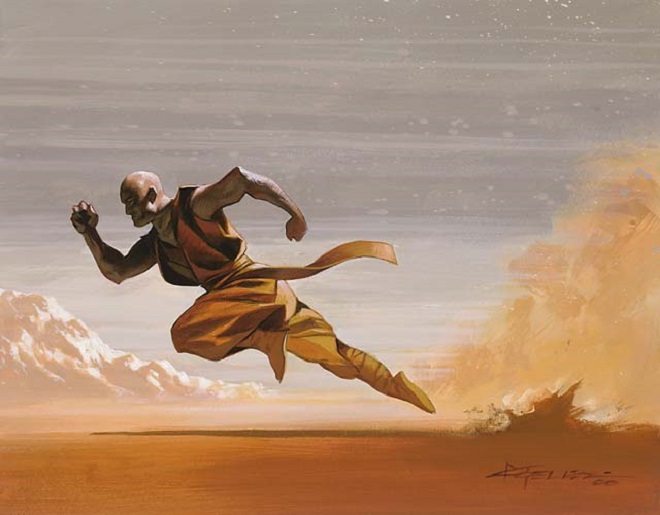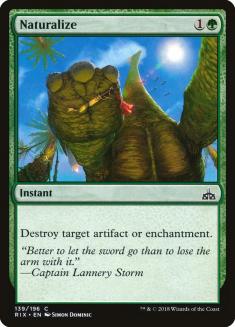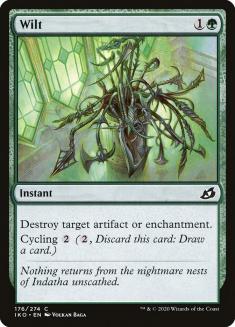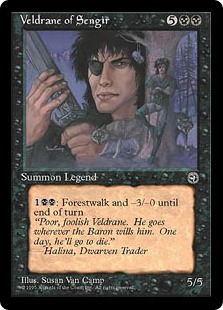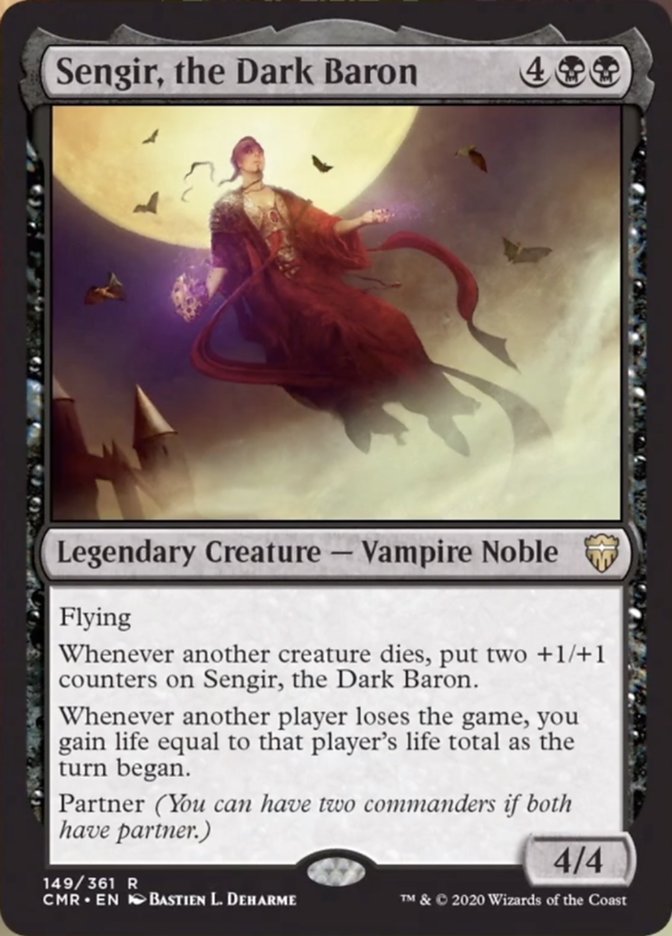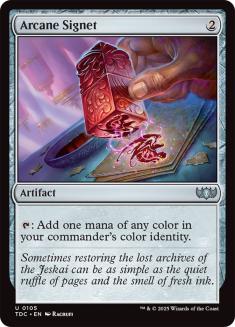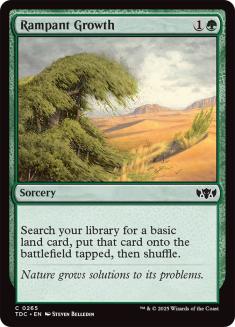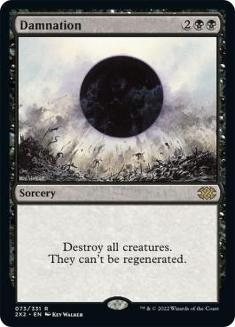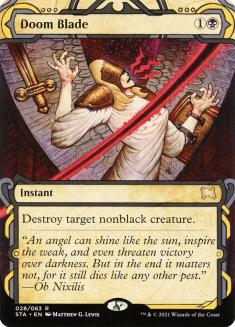Last year, when I talked about my Top 5 Concerns for Commander, number one with a bullet was fast mana and speed creep. Since the topic was only part of a larger discussion, we couldn’t really delve into it in as much detail as it may have warranted. I’d like to tease out some thoughts on it at greater length here. I want to address the titular question, “Should we solve speed creep in Commander?” as well as the natural follow-up, “Can we solve it?”
First, let’s define what speed creep is. It’s the assertion that Commander games are getting faster and ending sooner, and that the phenomenon is caused or amplified by insertion of cheaper and more efficient cards into the larger pool with every new set. To some, it’s the natural development of the game, a thing to embrace. To others, it’s an impediment to enjoyment, an urge to resist. And to everyone, it seems, it’s a topic of discussion.
Speed Creep or Power Creep?
Speed creep is often naturally confused with power creep. Power creep is the development of strictly better cards (although that term is generally misused), those that do more than their predecessors for the same or cheaper cost. A simple example is Wilt from Ikoria: Lair of Behemoths over Naturalize, which was first printed in Onslaught and last seen in Magic 2019. Both are instants that cost 1G. Both destroy an enchantment or artifact. Wilt also adds cycling 2. It’s a small difference, and one that’s not particularly game-breaking, but has more upside nonetheless. Other than some kind of flavor (or weird accessibility, which isn’t the case since a common from a recent set), there’s no reason to play Naturalize over Wilt.
We’ve seen greater evidence of power creep in creatures. Take for example Erithizon, from Mercadian Masques, a 4/4 creature for 2GG. It has the triggered ability to put a +1/+1 counter on a creature of the defending player’s choice when it attacks. Compare that to Questing Beast at the same cost, power, and toughness. It has vigilance, deathtouch, haste, plus two static abilities and one triggered—all of which are upside for its controller. Creatures sure have come a long way.
While power creep can lead to speed creep, they’re not synonymous. The former is about individual cards; the latter is about games as a whole. Speed creep is about the critical turns of a game coming earlier than ever.
Anecdotal Evidence
It’s clear that we have some evidence from content creators that games have sped up some. Also, the regularity with which people mention it is reason enough to believe that it’s the case. Anecdotally, among the player base who aren’t content creators, we also find it a common refrain, so we must give it due consideration.
Even if it’s not the case amongst some significant portion of the community, it’s real enough that we have to pay attention. While we can’t be 100% sure that things have sped up so significantly across the broader format, I’ll operate under the assumption for the purposes of this discussion that they have (otherwise, it doesn’t make much sense to have the conversation in the first place).
I want to make sure that you understand we’re talking about the broader parts of the format, not the ones dedicated to pure speed. We’re not talking about games that are dedicated to the possibility of ending on Turns 1-3 (or maybe even 4), but games that are intended to be played out more slowly. The higher-powered games can’t actually get much faster, and there’s some evidence that they actually last more turns than most folks think they do, even if they can threaten to end earlier.
Anyway, what we’re discussing here is what I’ll hesitantly call normal games of Commander. By using the term, I don’t want to suggest any abnormality on the fringes. It’s just convenient shorthand so that I don’t have to explain every time that I’m not negatively criticizing any play style.
Contributors to Speed Creep
In order to frame our examination, let’s explore some of the contributing factors to speed creep.
More Efficient Cards
We’ve already mentioned cards that are more efficient, but on the whole, I consider that a minor factor. Studio X has done a decent job of lateral development, especially in the past couple of years. The Wilt over Naturalize example is a good one because of what I mentioned—it’s certainly better, but not in a game-breaking form. Tacking cycling or scry onto an existing card to spice it up a little is a reasonable way to address the idea that the game has to evolve—but you don’t have to let that evolution run away from you.
One of the reasons that creatures have gotten so much better over the years is that, for the most part, they were just truly bad in the old days. If you don’t believe me, look at Baron Sengir or Veldrane of Sengir from The Dark. You don’t even need to compare them to Sengir, the Dark Baron from Commander Legends to get how bad it was (as a side note, I still advocate playing bad cards in Commander; again, that’s an entirely different discussion).
If card design is a lesser factor (I don’t want to call it minor), then the greater factor is a shift in the attitude of the Commander player base. There are to me clear reasons for this shift—and please don’t read into me suggesting any moral value to anything here.
Changing Players
Back when the format was young, we intentionally embraced longer games. As a social format first, we liked the longer game because it gave us more chance to socialize. Those of us who played the format in the before times gravitated to it because of its difference. We bought into the format’s lore of being about longer, durdlier games that weren’t necessarily about winning, but just about doing stuff. Silly stuff, sometimes with cards you’d never see played elsewhere. It stayed that way for quite a while.
Once more people became aware of the format via the introduction of Commander product, attitudes slowly shifted. When the format exploded in popularity, we had legions of players who hadn’t been exposed to the format’s origins or lore. Many of them didn’t even know there is a philosophy document (and to this day, many players don’t know/don’t care). They only knew the format mechanically.
That brought a different attitude which privileged efficiency and optimization over the social experience. We can add on top of that the decay of other formats and their competitive focus—which again prioritize the mechanical over the social. As these formats became less popular, players matriculated over to the one that was healthy, bringing with them new attitudes. Once, “serious” players wouldn’t consider Commander. Now it has plenty of serious players.
I’m not saying these attitudes are inherently bad, simply that they can steer Commander away, not just from its roots, but from its current focus on the primacy of the social experience. Some will argue the format’s roots aren’t relevant in today’s context. Others, like Civilization devs Sid Meier and Soren Johnson, will argue that designer intentions are irrelevant to the game itself. Nonetheless, we’re going to stick with our long-standing philosophy and direction.
Natural Evolution
The final thing that got us here is that efficiency and optimization are just natural evolutions for a player in any game. It’ll simply happen that players will want to get better at the game in question. There’s a ceiling—not everyone is driven to hone their skills to pro play level or whatever you might consider the elite level to be—but in general, players of TCGs will want to acquire better or more efficient pieces (assuming they’re affordable, which is a whole different conversation). I’m not talking about dismissive and condescending git gud, scrub attitudes, but the internalized desire to want to level up.
I actually think that this is a part of the discussion which gets ignored. We need to consider it when talking about how players approach the format. We can stay social and still want to have cooler cards or build tighter decks. Regardless of one’s place on the casual spectrum, we can see how the natural evolution of a player’s mentality can contribute to speeding up things. The desire to want to do more or better is real.
Tackling Speed Creep
What got us to where we are, then, seems pretty natural and reasonable. There are, however, plenty of players who’d prefer we slow down things some. These are the ones that consider speed creep problematic. I’m obviously one of them. If we consider it a problem, then we have to examine how it appears in the games we play.
What’s interesting to me in this whole discussion is that while the speeding up of the format is a somewhat new phenomenon, the cards (other than Arcane Signet, as we’ll see momentarily) aren’t new at all. They’ve existed as pieces in Commander back as far as the EDH days. If the game pieces existed but weren’t used in the percentages that they are now, we have to recognize the attitude shift as the primary driver.
Again, what we’re talking about here isn’t the explosive, early-turn, fast mana/mana positive game, but one that’s not going to threaten to be over on Turn 3 or 4. In what I earlier dubbed a normal game, speed creep has mostly manifested itself in one of two ways, sometimes combined: rocks and ramp. Ramp mostly exists in green and involves putting more than one land onto the battlefield in a turn. Rampant Growth (from which ramp draws its name), Cultivate, and Skyshroud Claim are popular ramp cards on the 2-3-4 curve. Green has the additional option of one-drop mana creatures, like Llanowar Elves, Fyndhorn Elves, and Noble Hierarch, which accelerates things even faster.
Rocks and Redundancy
(Mana) rocks are available to every color and come in artifact form. The ones in question are the two-mana versions, of which there are plenty. There’s the admitted design mistake of Arcane Signet. There are the Ravnica Signets, like Boros Signet, which are the OGs and benchmark for two-mana artifacts. There’s Fellwar Stone, Thought Vessel, and even the Mirrodin “pain signets,” like Talisman of Indulgence. There are so many of them that you can pack your deck with enough to guarantee that you’ll be nearly always able to cast one on Turn 2. I’ve said for a while that Sol Ring isn’t the problem; Sol Ring with backup is the problem. Mana rock into mana rock is the problem.
Speeding up things isn’t the only negative here. If the build of every Commander deck starts with Command Tower, Sol Ring, Arcane Signet, and the Signets of your colors, you’ve cut the number of other cards that you can put into the deck by five or six. Homogenization is a net negative. When there are cards you feel you must play, there are then fewer slots for cards that you want to play. Creativity becomes another casualty to efficiency.
Significant Action
The combination of speed and power creep means that the significant action comes earlier in the game. This kind of pressure changes the nature of the games that get played. Instead of easing into a game, you’re on alert early for what might be significant threats. That changing nature of the games means changing the focus of your decks. Whereas in a slower game you might be able to rely on battlefield sweepers like Damnation or Akroma’s Vengeance to take care of your creature problem, you’re pushed into playing a narrower set of targeted answers. Whether that’s cheap/free counterspells or inexpensive targeted creature removal, like Swords to Plowshares or Doom Blade, you’re building with more constraints.
As a side note, I believe that even in slower games, players will have better experiences if they play some more targeted removal, and not just for creatures. It’s just that the pressure of speed creep means that you’re forced into playing the cheaper or more efficient ones. There’s a prevailing attitude that a six-mana spell, like Hex, is too expensive—not too expensive for what it does, but too expensive to get cast in games. We get further restriction of what cards are considered “playable.” This leads to the opposite of what we want and what many players have said they love about the format—its access to nearly every card in Magic’s history and wide open possibilities for self-expression.
Can We Solve Speed Creep? Should We?
Having examined the causes and effects of speed creep, we have to wrap around to the initial questions of should and can we solve it. “Should” actually means “do we want to/is it better if?” since there really aren’t any moral imperatives here. To some extent, “can” also informs “should,” since if you simply can’t reasonably solve a problem, you live with the lesser effects than the solution would create. Invariably, the two questions don’t exist independently, but are intertwined.
The answer to “can” is “not reasonably and not in a fashion that people normally associate with solutions to Magic format problems.” We cannot ban our way out of this. Banning Sol Ring and Mana Crypt doesn’t do anything about all the two-mana rocks, ramp, and cheap mana creatures. Banning all of them would be ridiculous.
As we’ve seen, trying to create solutions by card design has had limited success. Dockside Extortionist didn’t answer the mana rock problem; it made it worse. It’s like Magic’s version of Cold War nuclear proliferation. Culling Ritual is closer to an actual solution that really might only bring you back to parity and has obvious color limitations. In my Najeela cEDH deck, I’ve gotten some mileage out of Zealous Persecution, but that obviously only impacts creatures.
The Social Solution
The best current answer we have is the social solution. This doesn’t by the way, involve aggressively insisting that people not play mana rocks. It means that being clear that you want to play a slower game and finding others who want to do the same. Maybe it means trying to get more people on board with the joys of the slower game. If that’s not what they want, don’t be pushy about it.
Finally, we come to the “should” part. Being that I’m a proponent of longer games, I think my answer will surprise some folks. I’m a firm no here. I’d rather we have more open availability of cards to people and then be able to hone our personal experiences. I’m sure the fact that there’s no good traditional option of solving the problem colors my logic here, but I’m firmly of the mind that a smaller banned list is better than a large one. More options for players (to a reasonable limit) means more likelihood of finding games they enjoy.
Speed Creep and Format Health
The most important take I have on this issue is that even though speed creep is a top problem, it doesn’t mean the format is unhealthy. While it might be a trend in many circles, it hasn’t reached any kind of epidemic proportions across the board. I’m not worried that the trend of playing a dozen mana rocks will lead to a stampede of people rushing towards those Turn 1-3 decks. Even if it impacts a large number of games, it’s not such a crushing problem that we’d need to consider a nuclear option. Commander is doing just fine. While speed creep is something we definitely want to keep our eye on, it’s a minor issue, not a life-threatening condition.
As always, if you’d like to discuss this or any issue, pop on over to the RC Discord server. In addition to a slew of other channels, there’s one dedicated to format philosophy where you can engage with RC members or a community of over 6,000 registered users. I hope to see you there.
Visit my Decklist Database to see my Signature Decks, the Chromatic Project, and more!

